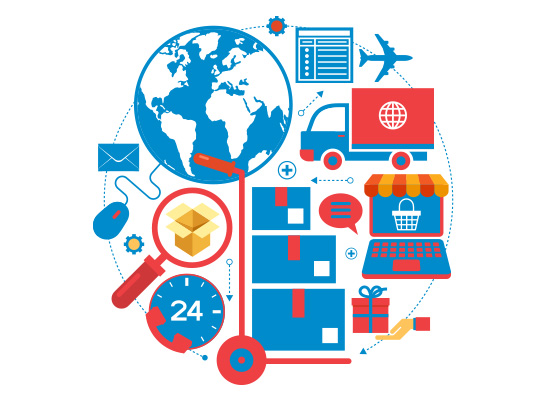Delivery is now a key selling point and competitive differentiator in the multi-channel retail world but requires the right balance of delivery options to meet both the customer’s and the retailer’s needs. Have you got the balance right?

Delivery used to be the bugbear of retailers frustrated at their inability to control the final part of their customer journey. The delivery stage often left them at the mercy of carriers whose services were much slower to catch up with the digital age and whose handling of the customer was, quite simply, outdated. Today, that has changed, and delivery now offers significant competitive advantage if it’s done correctly. However, it requires a balance that suits both parties – customers want convenience, retailers want to control costs but still win the sale.
New players, new rules
Customer demand for more convenient and reliable delivery options has seen dramatic change within the delivery services market. Carriers have had to reinvent their offering and provide tracking facilities as standard as well as look to introduce increasingly sophisticated services. The market has also seen the entry of new specialist delivery services whose innovations have forced market evolution. One example of this is Shutl, now owned by eBay. Its same day delivery services, which include a 90 minute delivery option within specific locations, have forced a same day norm among retailers.
Retailers need to consider convenient delivery options; as part of their customers’ overall user experience and to improve customer service. They must also ensure they have the right back-office IT systems in place to manage these faster, more complex delivery options. The market has also seen the introduction of parcel consolidators such as MetaPack and GFS to help retailers manage the complexity of offering the most cost effective delivery services to their customers. Today, getting delivery right is a customer loyalty winner.
A growing market here and abroad
And it’s not just about business at home. Ecommerce Europe estimates 3.7 billion B2C parcels are sent each year in Europe. Shopper numbers buying crossborder online are set to grow by 38% to 130 million by 2018, with the amount spent up 200%. Identifying the most cost effective range of international delivery options is therefore vital.
Embracing a full range of multi-channel delivery services
Retailers need to adopt a wide range of delivery options to provide the most cost effective, convenient delivery options that suit both them and their customers. Delivery costs range from free to £116 depending on the sector for the top 50 retailers, according to Practicology’s Fulfilment Index.
Free delivery normally applies to standard delivery but this, and premium next day delivery options, are simply no longer enough to offer. Although 70% of retailers in the UK say next day delivery options drive repeat purchase and increases customer lifetime value, customers want more and are willing to pay for a wider range of convenient options that better suit their lifestyles.
Many leading retailers now offer a plethora of delivery options. John Lewis, for example offers standard delivery, next or named working day, next or named working day before 10.30am, express 48 hour delivery for selected appliances and 2 or 4 hour delivery slots on selected furniture and appliances. The retailer offers a range of delivery premiums ranging from free to £19.95. These are then complemented by options such as click and collect in-store or in third party location networks such as Collect+.
Recognising the potential of click and collect and newer delivery options
One of the most effective delivery options is click and collect thanks to the benefits it offers, both to the customer and the retailer. It reduces shipping costs, pulls the customer in-store and eliminates traditional delivery barriers while offering the potential for increased sales. Customers have embraced it with the number using it set to grow from 35% to 76% by 2017. Some 38 of the top 50 retailers now offer some sort of click and collect service.
Retailers can improve convenience by offering wider options, though only 14% of retailers offer more than one collection point. Research shows that locker networks are used by 4% of online shoppers and third party stores by 12%. The range of delivery options continues to increase through third party collection points and in-store networks such as Collect+ and Hermes Parcelshops. Amazon has also announced a same day collection service at 500 newsagent and convenience stores in the Smiths News Group and a locker network that includes Birmingham International Airport and London tube stations. Even non-store retailers such as eBay are getting in on the act using Argos stores as a third party collection store for their deliveries.
Delivery can’t afford to stand still
In a market where speed is most definitely of the essence, retailers can’t afford to stand still. Efficiency is key. Standard expected delivery times have shortened to between two and three days for some retailers and a maximum of five days for half of the top 50 retailers according to Practicology’s Fulfilment index. The new range of delivery options offer increasingly tight delivery windows. However, retailers have to manage what’s right for their shoppers and for their business. This means there will likely be an increasing move to using store networks, as well as shipping directly from suppliers – especially internationally – to continue to improve delivery options while balancing the costs of these services. Stores, suppliers and carrier systems will become more intertwined than ever. Ensure that your business is ready to deliver on these new trends.
Remember:
- Offer a wide range of delivery options but don’t overwhelm customers.
- Make delivery work for your customer – and for you.
- Offer a click and collect service. It reduces shipping costs and allows you to upsell in-store.
- Remember your shipping costs on returns – not just on delivery.
- Don’t discount the idea of free P&P and returns. Such offers may require an additional overhead but are proven to be a key persuading factor in purchase decisions.
- Providing choice meets customer demand for a range of convenient delivery options. Importantly, customers are sometimes willing to pay a premium, which should cover the cost of offering the service.
Increase your business’ competitive advantage in multi-channel retail by downloading your free eGuide: Grow your business to survive: how to compete in an omni-channel world.
Topics: multi-channel delivery




